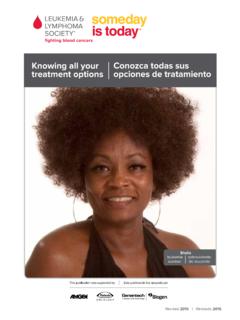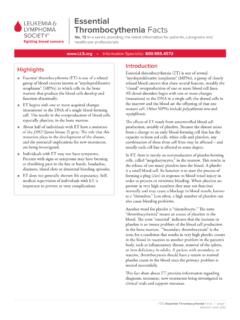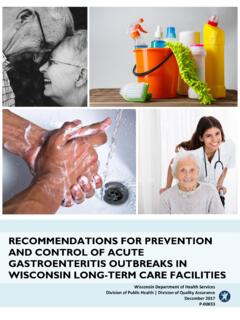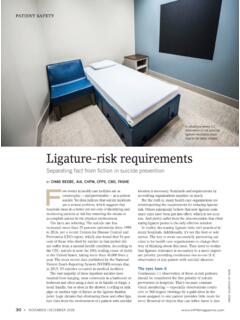Transcription of Acute Myeloid Leukemia in Adults
1 Acute Myeloid Leukemia in AdultsRevised 2021 PROVIDING THE LATEST INFORMATION FOR PATIENTS & CAREGIVERSS upport for this publication provided byA six-word narrative about living with blood cancer from patients in our LLS CommunityStay strong and keep moving forward. Find the positive in every day. Be your own best patient advocate. Changed my life for the better. Accept, learn and focus on present. Learning to live a different life. Sudden and life changing be positive. Waiting, worrying, anxiousness/happy I m alive! Embrace a new normal each day. 5 years, 41 infusions, constant fatigue. Patience, positive attitude, hope and faith. Test to test, I will survive! Treatment, fatigue, treatment, fatigue and survival. Love life, live better every day.
2 I don t look back only forward. So far, so good, live life. Meditation, mindfulness, wellness, faith, nutrition and optimism. Finding the joy while living with uncertainty. Watch, wait, treat, regroup, rest, re-energize. Blessed to be doing so well! Eye opening needed learning and healing. Feel great: uncertain travel plans annoying. Renewed faith, meditation, diet, mindfulness, gratitude. Watchful waiting can be watchful worrying. Scary, expensive, grateful, blessings, hope, faith. Thank god for stem cell transplants! Do not know what to expect. Extraordinarily grateful, I love my life. Diagnosed; frightened; tested; treating; waiting; hoping. I m more generous, impatient less often. Embrace your treatment day after day. Live today, accept tomorrow, forget yesterday.
3 Strength you never realized you had. Challenging to our hearts and minds. Life is what we make it. Live life in a beautiful way. Discover what thousands already have at our online social network for people who are living with or supporting someone who has a blood cancer. Members will find: Thousands of patients and caregivers sharing experiences and information, with support from knowledgeable staff Accurate and cutting-edge disease updates The opportunity to participate in surveys that will help improve careInside This Book2 Introduction3 Acute Myeloid Leukemia Basics4 Signs and Symptoms6 Medical Tests14 Diagnosis and Cell Classification16 Treatment Planning19 Treatment32 Special Treatment Considerations33 Relapsed and Refractory AML35 Research and Clinical Trials37 Related Diseases39 Side Effects and Complications41 Follow-Up Care43 Treatment Outcomes44 Incidence.
4 Causes and Risk Factors46 Normal Blood and Bone Marrow48 Resources and Information52 Health Terms64 References This publication is designed to provide accurate and authoritative information about the subject matter covered. It is distributed as a public service by The Leukemia & Lymphoma Society (LLS), with the understanding that LLS is not engaged in rendering medical or other professional services. LLS carefully reviews content for accuracy and confirms that all diagnostic and therapeutic options are presented in a fair and balanced manner without particular bias to any one Leukemia & Lymphoma Society (LLS) appreciates the review of this material by:Eunice S. Wang, MDChief, Leukemia ServiceProfessor of OncologyRoswell Park Comprehensive Cancer CenterBuffalo, NYNew treatments may have been approved since this book was printed.
5 Check or call (800) I I This book provides information about Acute Myeloid Leukemia (AML) in Adults . This type of Leukemia is also known as Acute myelogenous Leukemia , Acute myelocytic Leukemia , Acute myeloblastic Leukemia and Acute granulocytic Leukemia . AML is the most common type of Acute Leukemia in Adults . An estimated 20,240 new AML cases were expected to be diagnosed in the United States in 2021. As of January 2017, an estimated 55,548 people in the United States were either living with or in remission from AML.* Although AML can occur at any age, Adults age 60 years and older are more likely to develop the disease than younger people. For more information about AML in children, see the free LLS book Acute Myeloid Leukemia in Children and the past several decades, advances in AML testing and treatment options have resulted in improved remission and cure rates, but much work remains to be done.
6 Researchers continue to study and develop new therapies in clinical trials for AML LLS, we know that the more you understand about your disease, the better you can take care of yourself: your mind, body and health. This book provides information about AML, explains tests and treatments for the disease, and lists new treatment options being studied in clinical trials. It also includes brief descriptions of normal blood and bone marrow, as well as definitions of health terms related to trust that the information in this book will provide you with a good working knowledge about AML or that it reinforces what you already know. We hope you will keep this book handy and that, should you ever feel alone in confronting problems, you will turn to it for information and guidance to find the support and resources you need.
7 We are here to help. * Source: Facts 2020-2021. The Leukemia and Lymphoma Society. April 2021. All LLS publications mentioned in this book are free and can be viewed, downloaded or ordered online at treatments may have been approved since this book was printed. Check or call (800) Visit to give suggestions about this book. Acute Myeloid Leukemia in Adults I 3 Acute Myeloid Leukemia BasicsLeukemia. Leukemia is a cancer of the blood and bone marrow. Bone marrow is the sponge-like tissue in the center of most bones, where blood cells form. Leukemia begins in one of the immature cells in the bone marrow. One or more changes (mutations) occur in the DNA of the cell, and it becomes a type of cancer cell called a Leukemia cell. The four major types of Leukemia are: { Acute Myeloid Leukemia (AML) {Chronic Myeloid Leukemia (CML) { Acute lymphoblastic Leukemia (ALL) {Chronic lymphocytic Leukemia (CLL) The different types of Leukemia are identified based on the rate of disease progression, as well as the type of cells that are involved in the progression (meaning how quickly the disease gets worse) is one of the factors that doctors consider when they classify Leukemia .}}}}
8 Leukemia can be either Acute or chronic. Acute leukemias develop and progress rapidly and typically get worse quickly if not treated. Chronic leukemias usually progress more slowly. Leukemia is also classified by the type of blood cell that becomes cancerous. Blood stem cells develop into two primary types: lymphoid and Myeloid . Lymphoid stem cells develop into a type of white blood cells called lymphocytes. Myeloid stem cells can develop into red blood cells, platelets or certain types of white blood cells (basophils, eosinophils, monocytes and neutrophils). Leukemia is classified as Myeloid (or myelogenous ) if the cancerous change originates in a Myeloid cell, or lymphocytic (or lymphoblastic ) if it originates in a lymphoid cell. See the free LLS book The AML Guide: Information for Patients and Caregivers for general information about Acute Myeloid Leukemia (AML) Develops.
9 There are three main types of blood cells: red blood cells, white blood cells and platelets. Red blood cells carry oxygen throughout the body. White blood cells help fight infections. Platelets help stop bleeding by clumping together (clotting) at the site of an cells begin as blood stem cells in the bone marrow. A blood stem cell may become a Myeloid stem cell or a lymphoid stem cell. In healthy bone marrow, these blood-forming stem cells eventually develop into red blood cells, white blood cells and platelets. 4 I I most cases of AML, a mutation or series of mutations in the DNA (genetic material) of a single Myeloid stem cell results in the formation of an immature white blood cell called a myeloblast. In AML, the abnormal myeloblast does not develop into a healthy, functioning white blood cell. Instead, it becomes a Leukemia cell (also referred to as an AML cell or blast cell ).
10 Genetic errors in the mutated cell cause the cell to keep growing and dividing, whereas a healthy cell would stop dividing and eventually die. Every cell that arises from the initial Leukemia blast also has the mutated DNA. As the Leukemia cells multiply uncontrollably and quickly accumulate in the bone marrow, they slow down or stop the production of normal, healthy red blood cells, white blood cells and platelets. As a result, there are too many immature blast cells (that cannot fight infections) and not enough mature, functional red and white blood cells and the time AML is diagnosed, the number of healthy red blood cells, white blood cells and platelets is usually lower than normal. Having low levels of blood cells may result in infections, anemia, and excessive bleeding or bruising. Medical TermDefinitionAnemiaLow red blood cell count Thrombocytopenia Low platelet count ( thrombocyte is another word for platelet) NeutropeniaLow neutrophil count (a neutrophil is a type of white blood cell)In rare instances, a tumor made up of AML cells forms outside the bone marrow.














